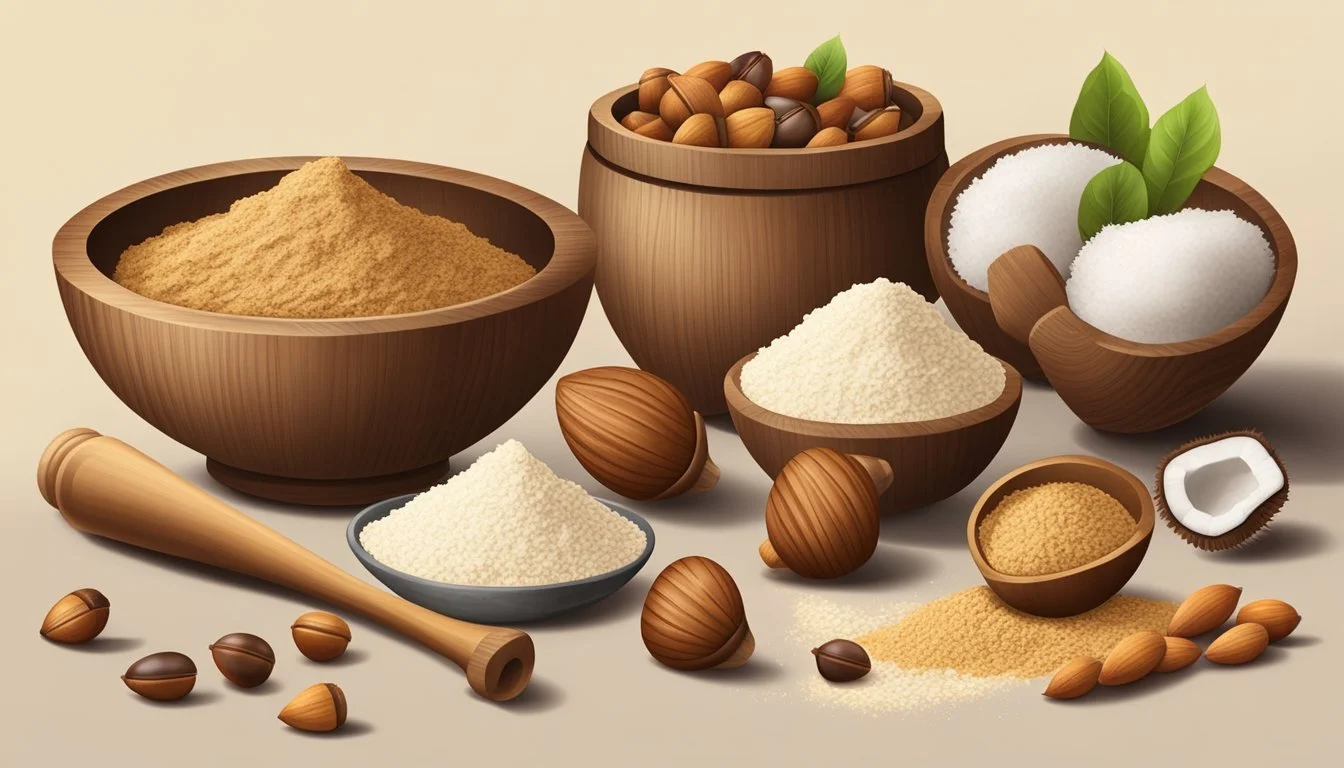Acorn Flour Substitutes
Best Alternatives for Cooking and Baking
Looking for alternatives to acorn flour in your cooking? Maybe you're out of acorn flour or looking for a different ingredient to fit your specific dietary needs. Several substitutes can seamlessly replace acorn flour in recipes while maintaining texture and flavor.
Corn flour is a commonly available substitute that offers similar binding properties. For those adhering to gluten-free diets, gluten-free flour mixes or sorghum flour can be excellent choices. Sorghum flour, in particular, imparts a slightly sweet, nutty flavor that can enrich your dishes.
Legumes like chickpea flour or ground flaxseeds can also serve as replacements, particularly in recipes where added protein and fiber are beneficial. Whether you're making baked goods or savory dishes, these options will ensure that your cooking remains nutritious and delicious.
Understanding Acorn Flour
Acorn flour, derived from oak tree acorns, offers unique nutritional benefits and versatile culinary applications. This section explores the nutritional profile of acorn flour and its common uses in cooking and baking.
Nutritional Profile
Acorn flour is rich in nutrients, offering a good supply of vitamins, minerals, and protein. It is known for being a gluten-free alternative to traditional flours, which makes it suitable for those with gluten sensitivities.
One of the standout features of acorn flour is its high tannin content. Tannins are compounds that can give a bitter taste but also have antioxidant properties. Proper processing, such as leaching, reduces tannin levels, making the flour palatable and nutritious.
Nutritional highlights:
Protein: Approximately 4 grams per 100 grams of flour
Calories: Roughly 200 calories per 100 grams
Essential Vitamins: B vitamins, particularly B6
Minerals: Potassium, magnesium, and calcium
Common Uses in Cooking and Baking
In cooking and baking, acorn flour is known for its nutty taste and versatility. It can be used to make a variety of dishes, from savory to sweet. Due to its unique flavor profile and texture, it can be employed in specific recipes, often as a substitute for other flours.
Popular uses:
Baking: Acorn flour can be used in bread, pancakes, and desserts. Its nutty flavor complements sweet ingredients well.
Frying and Breading: It can serve as a breading for meats and vegetables, adding a crunchy texture and rich flavor.
Thickening Agents: Ideal for soups and sauces where a thicker consistency without gluten is desired.
Combination: Often mixed with other flours to improve texture and flavor balance in baked goods.
Acorn flour's versatility extends to innovative recipes, allowing cooks to experiment with traditional and contemporary dishes alike. Whether used in pancakes or as breading for a savory dish, it introduces a distinct and rich taste.
Selecting Substitute Ingredients
Choosing the right substitute for acorn flour requires understanding key factors and comparing viable gluten-free options to ensure the best results in texture, flavor, and nutritional content.
Factors Affecting Choice
When selecting a substitute for acorn flour, several factors play a crucial role. Texture is paramount, as the alternative flour should mimic the fine, slightly gritty consistency of acorn flour. Flavor is another key consideration; while acorn flour has a distinct, nutty flavor, substitutes should complement the dish without overpowering it.
Nutritional content also influences the decision. Acorn flour is rich in fiber and moderate in calories. Alternatives like almond flour and coconut flour should provide similar health benefits. Lastly, considering whether the substitute is gluten-free is essential, especially for those with dietary restrictions. Examples include almond flour, coconut flour, and corn flour.
Comparing Gluten-Free Options
Various gluten-free flours can serve as substitutes for acorn flour. Almond flour is a popular choice, offering a high protein and fiber content with a mildly sweet, nutty flavor. It works well in baked goods but is heavier than acorn flour, potentially altering the texture.
Coconut flour, another good option, absorbs more moisture, requiring recipes to adjust liquid ingredients. It imparts a subtle coconut flavor, which may or may not suit the dish.
Corn flour is a versatile substitute providing a neutral taste and fine texture. It’s suitable for a range of recipes and maintains the light consistency expected from acorn flour. When choosing a corn flour substitute, consider its gluten-free nature and how it fits the overall recipe requirements.
Each substitute offers unique benefits, and selecting the right one depends on balancing texture, flavor, and nutritional needs specific to your culinary goals.
Flour Alternatives for Baking
When looking for flour alternatives for baking, a variety of options exist to cater to different dietary needs and flavor preferences.
Wheat-Based Substitutes
All-Purpose Flour: This is the most versatile substitute for any baking needs, providing a consistent and reliable texture.
Whole Wheat Flour: Rich in fiber, whole wheat flour is ideal for heartier baked goods but can result in denser products.
Self-Rising Flour: Containing baking powder and salt, this flour is convenient for recipes requiring leavening agents, such as cakes and biscuits.
Bread Flour: With a higher protein content, bread flour is perfect for yeast breads, providing strength and elasticity to the dough.
Non-Wheat and Gluten-Free Substitutes
Rice Flour: Commonly used in gluten-free baking, rice flour can be gritty but is effective for cookies and muffins when combined with other flours.
Tapioca Flour: This starchy flour is great for thickening and adding chewiness to gluten-free baked goods like cakes and breads.
Potato Flour: Offering moisture retention and a tender crumb, potato flour works well for gluten-free bread recipes.
Sorghum Flour: With a mild flavor, sorghum flour is best used in combination with other gluten-free flours and a binder for improved texture in baked goods.
These wheat-based and gluten-free flours can provide various textures and flavors, making them suitable for different types of baked goods.
Flour Substitutes for Thickening
Utilizing flour substitutes for thickening can be essential for those with dietary restrictions or preferences. This section explores various options that can be used to thicken soups, sauces, gravies, fillings, and stews effectively.
Starch-Based Thickening Agents
Using starch-based agents offers a smooth texture without altering the flavor of the dish. Cornstarch is a popular choice, easily mixed with water to create a slurry, which is then added to hot liquids. It is excellent for soups and sauces, turning them glossy and thick.
Arrowroot powder works similarly but is derived from tropical plants. It is ideal for acidic recipes and remains clear when cooked, unlike cornstarch which can turn cloudy. Potato starch is another alternative, often used in gluten-free cooking. It thickens quickly and is best added at the end of cooking to prevent it from breaking down.
Tapioca starch offers a neutral taste and is great for pie fillings and dessert sauces. It provides a strong thickening effect and helps maintain a smooth texture even when frozen. All these starches are suitable for gluten-free diets, making them a versatile choice in many culinary applications.
Flour Variants for Heavier Consistencies
For those seeking a more robust texture, various flour-based options can be utilized. Cornmeal and masa harina not only thicken but also enhance the flavor of dishes like stews and chili. They are also staple ingredients in many traditional dishes, adding a distinct taste.
Ground flaxseed serves as both a thickening agent and a nutritional boost, providing omega-3 fatty acids. When mixed with water, it forms a gel-like consistency, perfect for thickening soups and certain baking recipes.
Chickpea flour, made from ground chickpeas, is an excellent choice for those looking to add protein and fiber. It can thicken stews and sauces while imparting a slight nutty flavor. These flour variants are especially useful in recipes requiring a heavier or heartier consistency.
By incorporating these substitutes, one can achieve desired thickness and texture in a variety of culinary applications without relying on traditional flour.
Alternative Flours for Frying and Breading
When looking for substitutes for traditional wheat flour in frying and breading, a variety of alternative flours offer unique textures and flavors. Each type of flour can provide different benefits, such as creating a crisp crust or adding nutritional value without gluten.
Flours for Crispy Texture
Cornstarch is a popular choice for achieving a crispy texture in fried foods. When used as a coating, it provides a light, crunchy layer. It's common in Asian cuisine for frying chicken and tempura.
Rice Flour is another excellent option known for its crispiness. Often used in Japanese and Korean cooking, it helps create a light, delicate crust, ideal for fried fish and vegetables. Rice flour is naturally gluten-free and can be combined with other flours for improved texture.
Cornmeal can also be used to add a crunchy texture. Unlike corn flour, cornmeal has a grittier consistency, making it perfect for breading fish and chicken. Its distinct flavor adds depth to fried dishes.
Chickpea Flour is known for its binding properties and ability to create a firm, crispy coating. It's frequently used in Indian cuisine for dishes like pakoras. The nutty flavor can enhance a variety of fried foods.
Nut and Seed Flours for Breading
Almond Flour brings a mild, nutty flavor to breading. It's a low-carb and gluten-free option that's versatile enough to be used on a range of proteins, from chicken to fish. Almond flour provides a slightly softer crust compared to grain-based flours.
Coconut Flour is another alternative, particularly for those seeking gluten-free options. It absorbs more liquid than other flours, so it’s often mixed with other types to ensure an even coating. Ideal for adding a subtle sweetness to dishes, it's suitable for seafood and poultry.
Ground Flaxseeds offer a nutrient-rich option for breading, packed with omega-3 fatty acids. While they don't offer the same crunch as other flours, they provide a distinctive texture and flavor that can enhance various dishes. Mixing ground flaxseeds with almond or coconut flour can improve the overall breading.
By choosing the right alternative flour, delicious, crispy, and healthy fried and breaded foods can be achieved without the need for traditional wheat flour.
Culinary Techniques and Considerations
Modifying recipes to incorporate substitutes for acorn flour requires attention to cooking methods and understanding the inherent flavor profiles of the alternatives. Specific techniques ensure that substitutes integrate well, maintaining desired textures and flavors.
Modifying Recipes for Substitutes
When modifying recipes to use acorn flour alternatives, it is important to understand how different substitutes affect the dish. Consistency and texture play crucial roles in baking.
Measure flour substitutes accurately using a kitchen scale for precision. For baking, substitutes like oat flour or almond flour can be used. Oat flour tends to make baked goods denser, while almond flour adds a rich, nutty flavor and moist texture. Roasting or toasting substitute flours can enhance flavors.
For savory recipes, consider the moisture content. Adding a bit more or less liquid might be necessary to achieve the desired texture. Chickpea flour and coconut flour are good options, but they absorb moisture differently. Adapting the liquid components in your recipe accordingly can maintain the integrity of the dish.
Understanding Flavor Profiles
Flavor profiles of substitutes vary and should be matched thoughtfully to the intended dish. Almond flour and oat flour are milder and adaptable to many recipes. Almond flour's subtle sweetness pairs well with desserts, while oat flour’s neutrality makes it versatile.
Coconut flour, with its distinctive tropical flavor, can add an interesting twist but must be used in smaller amounts due to its high absorbency. Chickpea flour offers an earthy taste and works well in savory recipes like pancakes or bread. Incorporating seasoning or spices that complement the substitute’s flavor can enhance the overall taste.
Choosing the right substitute involves understanding these flavor nuances and balancing them with other ingredients to create a harmonious dish.
Specialty and International Substitutes
Exploring specialty and international substitutes for acorn flour can elevate your baking with unique flavors and textures. Discovering these alternatives opens the door to diverse culinary experiences.
Unique Flour Alternatives Worldwide
Cassava flour is a popular substitute in many countries, especially in Africa and South America. It is derived from the cassava root and is known for its neutral flavor and fine texture. It can be used 1:1 for acorn flour in most recipes.
Chickpea flour, also known as gram flour or besan, originates from India and the Middle East. It has a slightly nutty taste and can be used in savory dishes like flatbreads or batters. While it can replace acorn flour, it may alter the flavor profile slightly.
Masa harina, traditionally used in Latin American cuisines, is a type of corn flour treated with lime. It provides a distinct taste and works well in tortillas and tamales. This substitute is common in Mexican cooking and can also be found in various stores worldwide.
Tapioca flour, another product derived from cassava, is widely utilized in both sweet and savory recipes. Known for its elasticity, it is great for gluten-free baking, providing a chewy texture that mimics grain-based flours effectively.
Online Sources for Exotic Substitutes
Several online platforms offer specialty flours, making it easier to experiment with substitutions. Websites like Amazon, Thrive Market, and Bob’s Red Mill provide vast selections, including cassava flour, chickpea flour, masa harina, and tapioca flour.
In the UK, online shops such as Buy Whole Foods Online and Planet Organic stock a variety of these exotic flours. In America, popular grocery sites like Walmart and Whole Foods Market have extensive inventories of alternative flours for easy access.
Online publications and blogs often review and recommend these options, providing recipes and tips for using these flours effectively. This allows home cooks to incorporate international ingredients into their kitchens without hassle, expanding their culinary repertoire.
Dietary Considerations
When choosing acorn flour substitutes, it's essential to consider dietary needs such as allergy restrictions and nutritional requirements like calorie and protein content.
Substitutes for Allergy Restrictions
For those with gluten sensitivities or celiac disease, coconut and almond flour are excellent gluten-free alternatives to acorn flour. Coconut flour is highly absorbent and may need additional liquids in recipes, while almond flour offers a nutty flavor and moist texture.
However, nut allergies eliminate options like almond flour, making tapioca flour or rice flour more suitable for creating allergy-friendly baked goods. Despite being nuttier in taste, chestnut flour might also be an excellent substitute, provided no tree nut allergies exist.
Low-Calorie and High-Protein Options
For individuals monitoring their calorie intake, coconut flour is a low-calorie option with only about 60 calories per ¼ cup. Additionally, it offers dietary fiber, aiding digestion.
Chickpea flour is a high-protein substitute, containing about 6 grams of protein per ¼ cup. It complements vegan and vegetarian diets needing protein boosts. Quinoa flour, rich in both protein and essential amino acids, is another high-protein, gluten-free option.
For balance, using blends like buckwheat or teff flour can also offer nutritional benefits with moderate calories and protein, making various recipes both healthier and delicious.
Practical Tips for Storage and Use
Proper storage of substitute flours ensures their longevity and usefulness in various recipes. Adjusting liquid ratios when using these flours is crucial for maintaining desired consistency and texture in your dishes.
Storing Substitute Flours
To maintain the freshness and extend the shelf life of substitute flours, store them in airtight containers placed in a cool, dry location. Exposure to moisture can cause the flour to spoil or become clumpy. For long-term storage, consider using vacuum-sealed bags or containers with desiccant packets to prevent humidity from affecting the flour.
Refrigeration can prolong shelf life, particularly for nut-based flours like almond or hazelnut flour. Ensure the flour is in a sealed container to avoid odor absorption from other foods. If storing in the freezer, label the containers with the date of storage to keep track of its freshness.
Adjusting Liquid Ratios in Recipes
When substituting acorn flour, it's important to adjust the liquid ratios in your recipes. Substitute flours such as coconut flour absorb more liquid due to their high fiber content, requiring additional liquids like water, milk, or eggs. Aim to increase the liquid by 1/4 cup for every cup of substitute flour used.
For gluten-free options like rice flour or oat flour, consider adding binding agents like xanthan gum or psyllium husk to mimic the elasticity that gluten provides. Adjustments might also include decreasing the baking time or temperature slightly, as these flours can brown more quickly than wheat flour.
By implementing these practical tips for storage and use, you can make the most out of your substitute flours, ensuring successful and delicious results in your cooking and baking endeavors.








